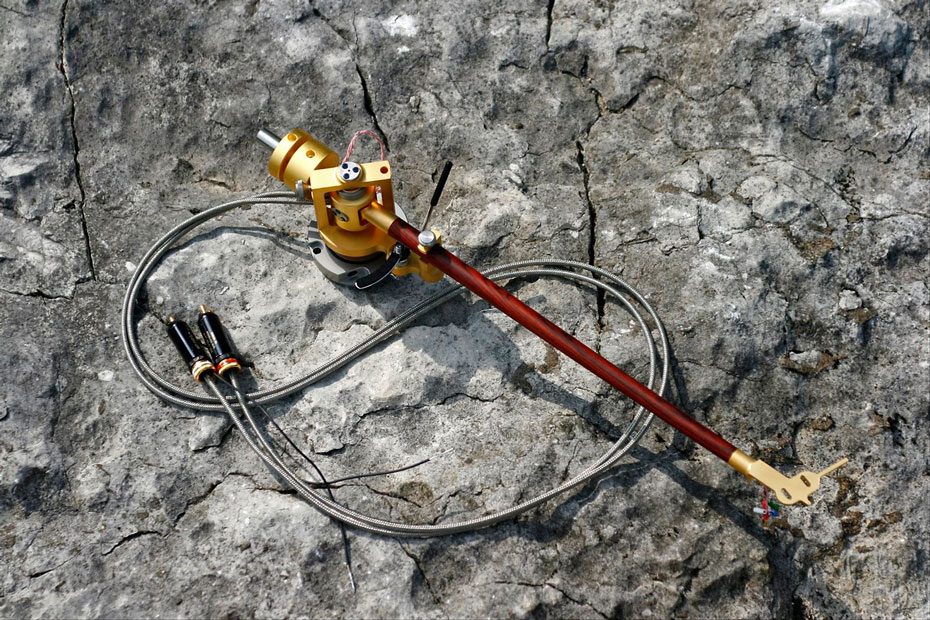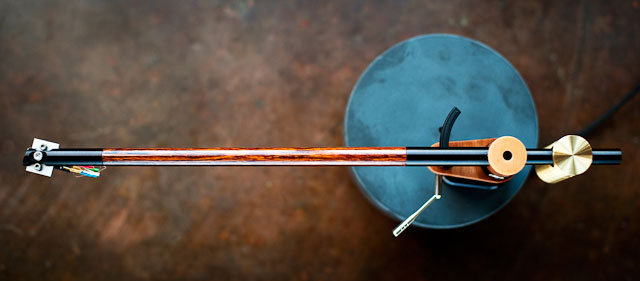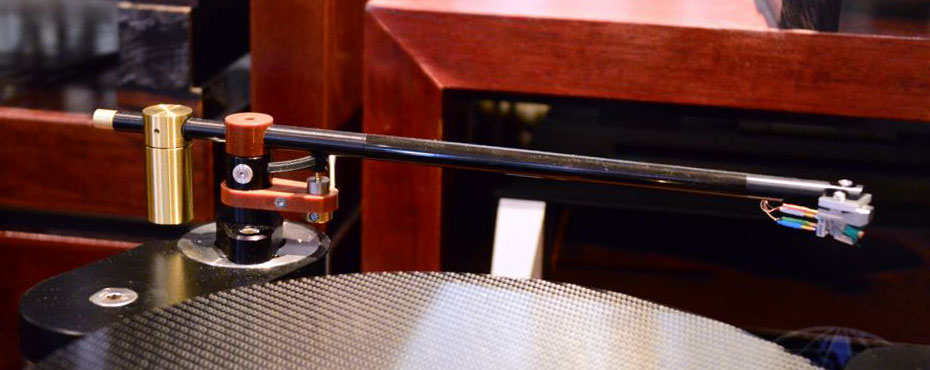This will be the first of a series of articles which I’ll be writing on tonearms. Part II will be on the all new DaVinci Master Reference Virtu Tonearm, followed by Part III which will be on the Durand Telos Tonearm.
“Rick, you have an “Ebony Fetish.” My friends are referring to the Diospyros kind of fetish. Diospyros Crassiflora is the botanical name for Gaboon Ebony which is a type of black wood endemic to Western Africa, named after the West African state of Gabon.
This ebony fetish story originated several years ago when I first saw the DaVinci Grandezza wooden tonearm. I vividly recall thinking it was the most beautiful tonearm I had ever seen – quite simply, love at first sight. I thought the Grandezza was at the same time, a beautiful amalgam of all that I treasure in a fine piece of craftsmanship — exquisite, elegant, precise and simple. I told myself I must own one of these arms regardless of the price, so I immediately got in touch with Peter Brem and Jolanda Costa of DaVinci Labs of Switzerland, to place an order for a 12” Ebony version through Mehran of SORAsound.com, who is the sole retailer for Da Vinci Lab’s products in North America.
Over the next few months, I found myself drawn again and again to the Grandezza in preference to all the other tonearms I had at the time, regardless of which cartridge was mounted. There seems to be an organic character and musicality to the sound which is distinctly different and absent on armwands made of other materials. The simplistic elegance of the design, and the musicality of the DaVinci Grandezza tonearm motivated me to replace other tonearms I owned, most of which were more complex and mechanistic in comparison, albeit well made and sonically pleasing. Aesthetically, I quietly know better, nothing came close to the Grandezza.
The DaVinci Grandezza Tonearm, now out of production. (Photo used with Permission, courtesy of Soundscapehifi.com & DaVinci Audio Labs).
Over the course of two years, I sold off the Triplanar, the Graham 2.2, the Graham Phantom, the Moerch DP-6, the vintage Audiocraft and SME in favour of tonearms with wooden armwands: the Schröder Reference 12” Ebony, the Reed 2P 12” Ebony, the Rossner and Sohn Si 1.2 12” (with an optional Panzerholtz wooden wand), and the Durand Talea II 10.5. Currently, six out of my seven tonearms have wooden armwands, mostly ebony.
The downside to all these 12” wooden tonearms are their hefty price tags. The DaVinci Grandezza retails at $11,000, the Schroder Reference at $7,500, the Durand Talea II at $8,500, the Reed 2P at $6,500, and the Rossner and Sohn Si 1.2 at $6,200. The new DaVinci Master Reference Virtu and the Durand Telos, which I will be reviewing in parts II and III of this article cost even more, at $14,995 and $16,500 respectively. And because these tonearms are mostly handmade, the wait time on some of them can be exceedingly long. I waited 9 months for my Grandezza, and a year and a half for the Schröder Reference.
When Ming Su, North American Distributor for Verdier and GOTO Horns, told me about the Artemis Labs TA-1 tonearm, he said “I have something which will tickle your fancy: Something designed by Frank Schröder, made by Artemis Labs in California, with a minimal wait time, 12” wooden armwand and with a price tag far cheaper than most of its competitors, at only $4,800!” Now $4,800 still isn’t exactly chump change, but in the rarefied world that top tonearms inhabit, positively affordable. A quick snoop around on Google on the Artemis Labs TA-1 tonearm landed me on Jonathan Weiss’ Oswalds Mill Audio (OMA) homepage rather than on Artemis Labs’ own website. Jonathan’s website houses some of the most beautiful photos of the Artemis Lab TA-1L tonearm taken by Cynthia van Elk photography.
Within the week, Ming put me in touch with Sean Ta, CEO of Artemis Labs, and he quickly obliged my request for a review sample. Under most circumstances I have a preference for 12” arms over 9”; accordingly, I advised Sean that my only condition was that the armwand had to be 12” ebony.
“No Problem”, said Sean, “12” Ebony it shall be, the arm is on its way, it will get to you in two weeks”. For the first time, in a long time, there was minimal waiting time!
The idea behind the TA-1 tonearm came about when dealers and distributors alike were asking Artemis Labs to recommend a tonearm that would complement their famous SA-1 turntable. Sean’s objective was to pair the table with a great sounding tonearm without all the complicated parts but with all the necessary adjustment parameters. He asked Frank Schröder, who designed the SA-1 turntable, to create a tonearm which follows the same design concept. In the analog world, Schröder’s name needs no introduction. His famous Reference tonearm is highly sought-after by analog lovers from around the world. The long wait time is perhaps the best indication of the tonearm’s demand and status.
Fortunately, there is now an alternative, the TA-1 carries a lead time of only 2-3 weeks, or so I’m told.
The Artemis Lab tonearm comes in two versions, the 9” TA-1 and the 12” TA-1L with a price tag of $4,600 and $4,800, respectively. The standard armwand material is made of Kingwood as shown in the above photo, but their ebony version can be custom ordered without an up charge. The wood has been treated to prevent warping or cracking, and to withstand humidity changes. The tonearm also comes standard with Eichman Bullet RCA plugs. XLR connectors can be custom ordered. My review sample came with Neutrick Silver XLR connectors, as the Burmester PH100 phono stage I used in this review accepts XLR inputs.
True to its design ethos, the TA-1tonearm appears clean and simple, and reminds me of the look of the Thomas Schick tonearm. Despite that, all the setup parameters, like Azimuth, VTA, VTF, antiskating and even armtube resonance are adjustable and well hidden within the tonearm. Although the pivot column appears like a unipivot arm, the TA-1 is neither a unipivot arm nor a gimball pivoted arm.
Frank Schröder actually came up with a completely new technology called the “Raised Hyper Ceramic Bearing.” The armwand is connected to the pivot column via two separate ceramic ball bearings, one controlling the horizontal movement and the other the vertical. The two bearings permit vertical and horizontal movement of the armwand, but not multi-direction or diagonal movements. According to Sean, the bearings have an unprecedented low level of friction (< 2mg). The tonearm bearing comes completely assembled and requires no user maintenance or assembly.
- (Page 1 of 4)
- Next page →




Hi, a great Review from a Music Lover. I´m from Austria the land with the great “Sophien hall” for record the best records from DECCA.
So i´m a classsical music lover and have now the possibility to buy a used 4point or a Schroeder CB. It should present big Orchestra without compression, or small quartets, tonal real instruments, fine breathe & air of the music
What would you suggest?
many thanks Gerhard